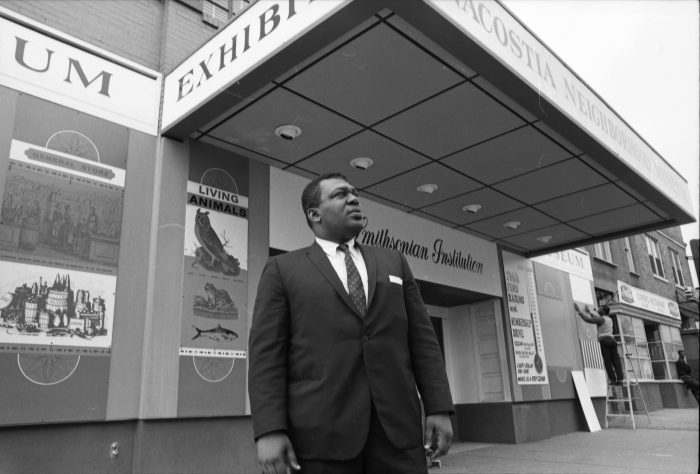Our People, Our Power
The creativity, dedication, and perseverance of Smithsonian staff and volunteers have never been more apparent than this past year. And I am confident that, 175 years from now, this is the generation that will make those who study history say: “look at the wonders they were able to accomplish.”
A few weeks ago, I stood in the Arts & Industries Building for the Smithsonian’s 175th anniversary celebration. Being around so many colleagues again was a lesson in opposites. The familiarity and the strangeness of encountering so many colleagues again. The joy of reunion and the uncertainty of whether such gatherings would continue to be possible in the months ahead. The reminder of how much we lost during a year of social distancing, and how much we gain when we come back together.
As we celebrated 175 years of innovation, growth, discovery, and creativity, I couldn’t help but wonder what the next 175 years might bring. We have grown into so much more than the institution that our founders imagined in 1846. But throughout all these changes – new collections, new museums, new research, new educational opportunities – one thing has stayed constant. Our people have always been the beating heart of this institution.
-

A studio portrait of Solomon G. Brown standing in front of a tropical backdrop painted with two palm trees and a shoreline scene. Brown is standing on palm fronds in a suit, polka dot tie, and bowler hat with his left hand in his trouser pocket. Brown served as a clerk at the Smithsonian from 1850 until 1906. (Photographer unknown, circa 1850) -

Franklin Odo is a Japanese American author, scholar, activist, and historian. He was the first Asian Pacific American curator at the National Museum of American History and founding director of the Smithsonian’s Asian Pacific American Center. (Photo by James Tourtellotte) -

Louise Daniel Hutchinson, Historian at the Anacostia Neighborhood Museum, now the Anacostia Community Museum, seated in her office in 1983. (Photo by Chris Capilongo, courtesy Smithsonian Institution Archives)
-

Former Secretary of the Treasury Anna Escobedo Cabral served as the director of the Smithsonian Center for Latino Initiatives, now the Smithsonian Latino Center, between 2003 and 2004. In this role, she led efforts across the Institution to improve Latino representation in exhibits and public programming. (Official US Treasury photo) -

Zora Martin Felton, an education specialist, in her office at the Anacostia Neighborhood Museum, now known as the Anacostia Community Museum in 1983. (Courtesy Smithsonian Institution Archives) -

Director John R. Kinard in front of the Anacostia Neighborhood Museum, now known as Anacostia Community Museum, May 1968. (Courtesy Smithsonian Institution Archives) -

Spencer R. Crew is currently the Clarence J. Robinson Professor of History at George Mason University and Emeritus Director of the National Museum of African American History and the National Museum of American History. Previous to Mason he served as president of the National Underground Railroad Freedom Center for six years and worked at the National Museum of American History, Smithsonian Institution for twenty years. Nine of those years, he served as the director. He most recently served as the interim Director at the National Museum of African American History and Culture. (Courtesy NMAAHC) -

S. Dillon Ripley, eighth Smithsonian Secretary (1964-1984), standing in the Secretary’s Parlor in the Smithsonian Institution Building in front of the portrait of Joseph Henry, first Secretary of the Smithsonian (1846-1878). (Photo by Charles Phillips, 1978. Courtesy Smithsonian Institution Archives) -

Evelyn S. Lieberman served as Director of Communications and External Affairs from 2002 until her death in 2015. During her tenure she oversaw the Smithsonian’s internal and external communications, the Office of Government Relations, the Office of Special Events and Protocol and the Office of Visitor Services. She served five Secretaries, and participated in many major milestones for the Smithsonian, including the opening of the National Museum of the American Indian, the renovation and reopening of the Donald W. Reynolds Center for American Art and Portraiture, and groundbreaking for the Smithsonian’s National Museum of African American History and Culture. (Photo by Tamara Hoffer)
Solomon Brown, whose wide-ranging talents and contributions supported the Smithsonian for 54 years. Louise Hutchinson, Franklin Odo, and Anna Cabral, who pushed the Smithsonian to build a broader understanding of what should have a place in history. S. Dillon Ripley, who transformed us into a place of greater reach, accessibility, and relevance. Zora Felton, who knew that museums must listen before they try to teach. John Kinard and Spencer Crew, who changed the way I understand my own role as a historian, a curator, and a museum leader. Evelyn Lieberman, whose political savvy and profound candor pushed everyone around her to achieve their best.
And today, I am more in awe of our people than ever. Folks who adapted to new digital platforms while juggling the needs of home, families, and loved ones. Folks who donned masks and came in person to protect our facilities, safeguard for our collections, manage experiments, or care for our animals. Folks who went onto the streets to collect items from protests, to listen to the stories of those they encountered, to ensure that the Smithsonian could preserve those stories for posterity.
The creativity, dedication, and perseverance of Smithsonian staff and volunteers have never been more apparent than this past year. And I am confident that, 175 years from now, this is the generation that will make those who study history say: “look at the wonders they were able to accomplish.”
Posted: 31 August 2021
- Categories:







